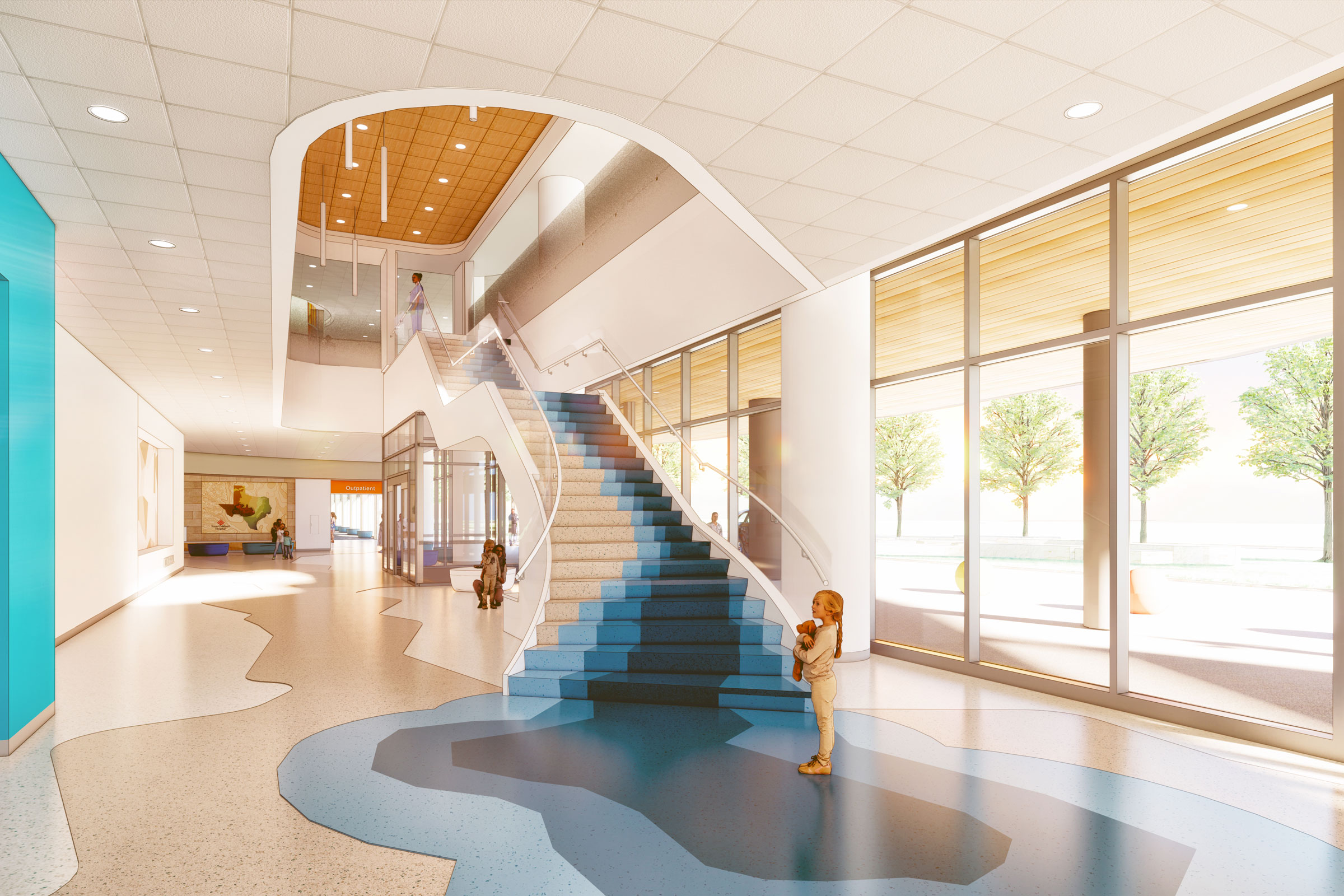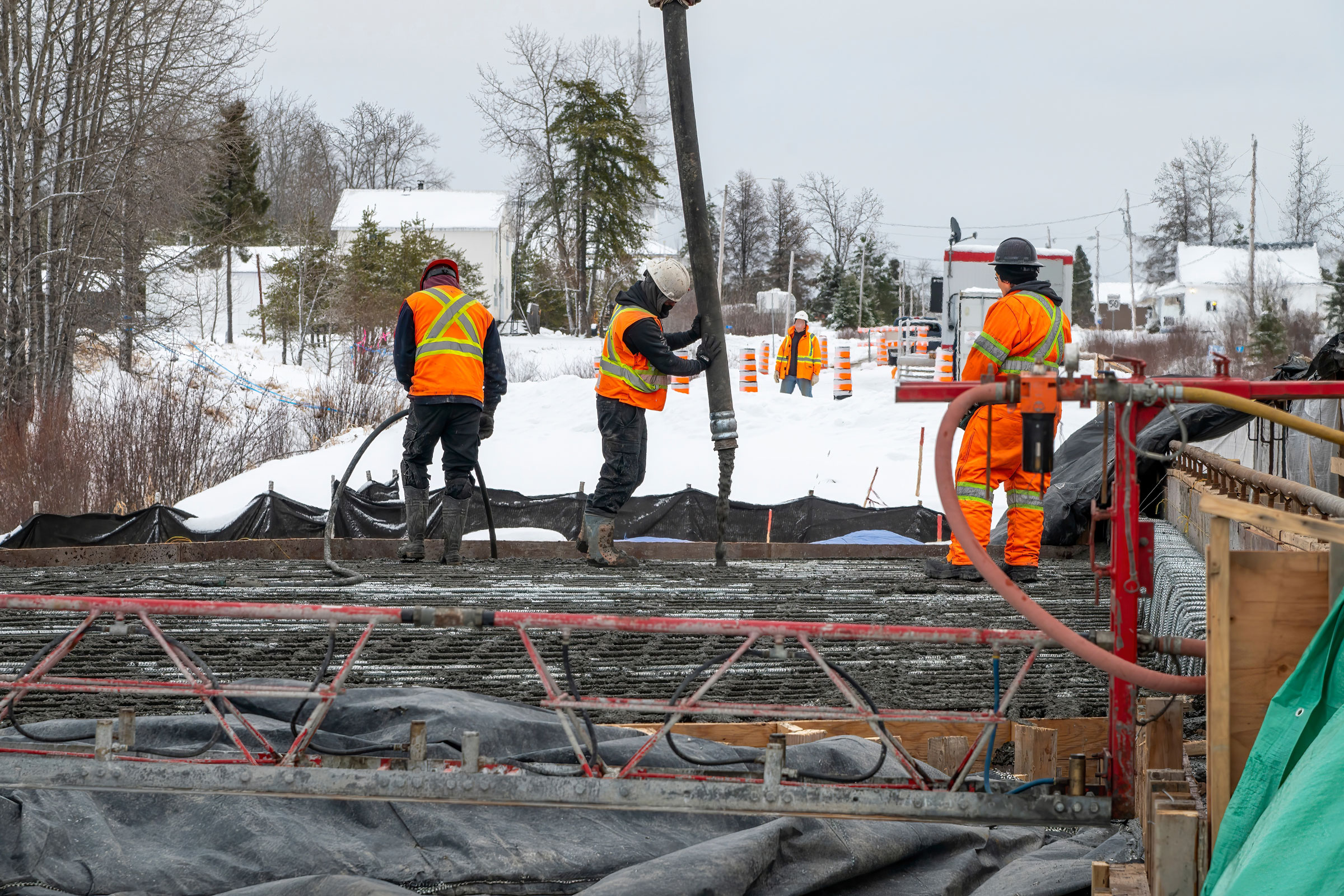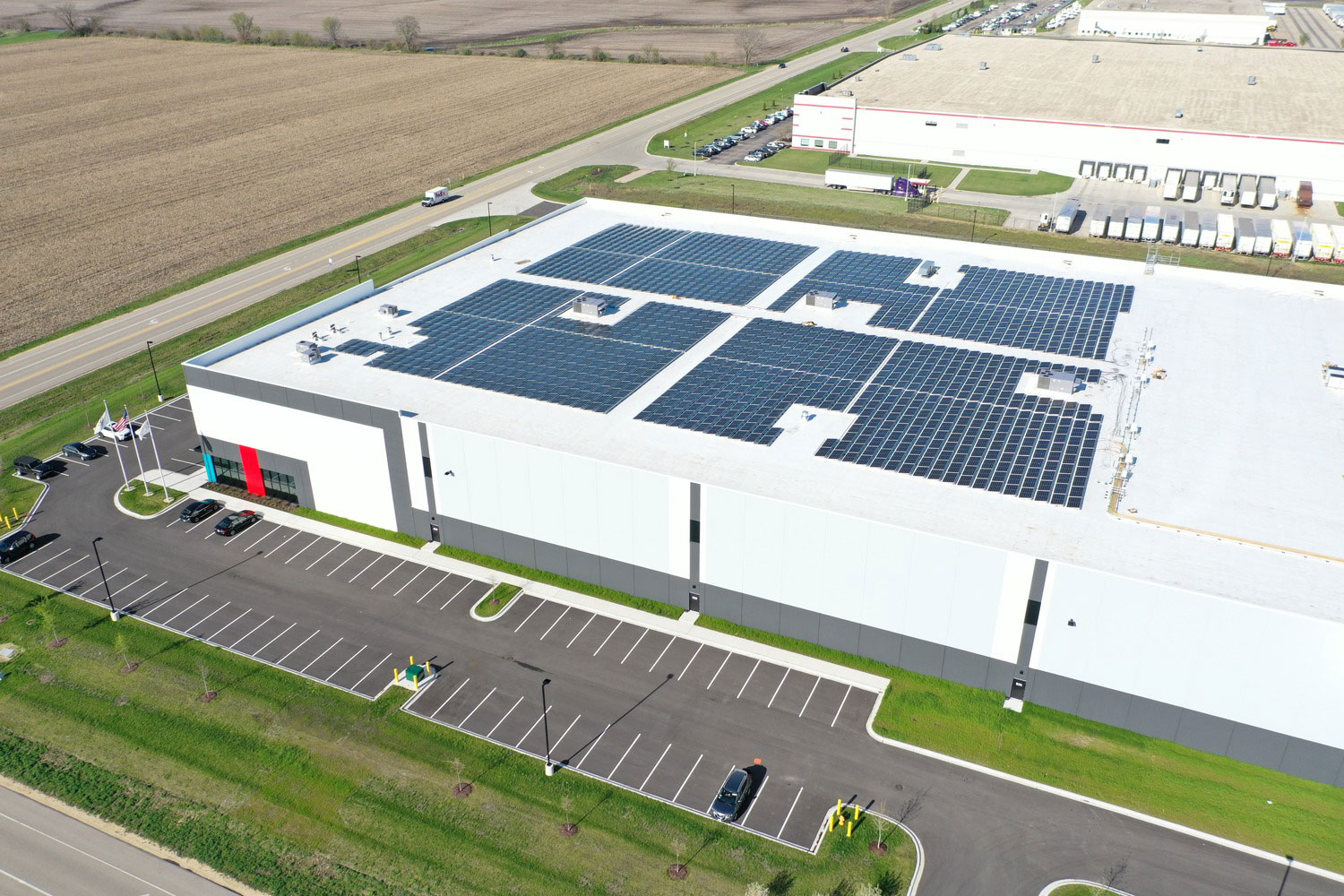Story at a glance:
- Texas Children’s Hospital is building a new campus in Austin meant to be a beacon of healthy, sustainable design.
- The new 52-bed facility is scheduled to open in 2024 with intensive care units, operating rooms, a sleep center, emergency center, diagnostic imaging, urgent care, and more.
- Outdoor spaces, lots of windows, and a neutral palette with splashes color are core parts of the design.
Some of life’s most emotionally charged moments happen in hospitals. Births, deaths, treatments, recoveries, milestones—they happen moment by moment in every hospital around the world. Traditionally interior design in hospital settings has focused on efficiency and safety, essential components of health and healing. But with a growing emphasis on healthy spaces and sustainable materials across the design industry as well as on treating the whole person in medicine—including mental and emotional health—hospitals have begun to evolve from the inside out, creating unique and healing experiences that go far beyond the physical.
“The materials industry has caused that shift,” says Jill Pearsall, senior vice president of facilities planning and development at Texas Children’s Hospital. “Manufacturers have either been forced to change what they put in their materials or chosen to be more sustainable. And I think that’s a good thing. They’ve forced us as facility owners to adopt new products that are better for the environment—better for the internal environment and better for the global environment. The paint, carpet, flooring manufacturers—they’ve changed their ways, and we’ve adapted because it’s what’s available and because it’s the right thing to do.”
Creating spaces that heal patients—that’s what hospitals have always striven to do. And with new data on how essential the built environment is to physiological health, not to mention the health of communities and the world, it just makes sense on even the most practical level, Pearsall says. Add in a layer of new regulation in places like Austin, Texas, where Texas Children’s Hospital’s newest campus will be located, and you have the recipe for some truly innovative changes in the industry. “We’re required to meet the two-star rating for the Austin Energy Green Building (AEGB) program. We are going to not only design this facility to meet that two-star or higher level, but we are also going to layer in an educational program within the campus, designed to teach people what have we done to be sustainable, to be respectful of the environment, and hopefully even teach kids that those things are possible.”
Designing Welcoming Environments

Creating outdoor spaces for rest and rejuvenation for both staff and patients was a critical part of this design. Rendering courtesy of Texas Children’s Hospital
Planning for this ambitious project in Austin began at the height of one of the worst medical disasters in modern history, but that didn’t temper the enthusiasm. By March 2020 Pearsall and her team were putting their heads together (while remaining safely distant) to craft a truly innovative space.
Slated to open early 2024, this $485 million campus will include a 365,000-square-foot, 52-bed facility designed to serve both women and children with neonatal and pediatric intensive care units, operating rooms, epilepsy monitoring, a sleep center, an emergency center, advanced fetal interventions and surgery, diagnostic imaging, acute care, and urgent care. Next door, a 170,000-square-foot outpatient building will focus on subspecialties like cardiology, oncology, neurology, pulmonology, fetal care, and others.
“Looking at the pediatric growth in this area of Austin, as well as the women of childbearing age, we really saw that the drive for us to go into Austin was to bring in specialists on that higher acuity of care—heart programs, neurosurgery programs, high-risk women’s programs—bringing that to a place where, right now, those patients have to go to Dallas or Houston or San Antonio for those services. Bringing that high expertise of many of our clinical programs to central Texas was important.”
Equally important was imagining the kind of people who would eventually use the space and designing it to fit them. “Health care in general has evolved over many years to adopt hospitality-type character and feeling,” she says. But for this kind of hospital, it was a unique challenge. “Having worked at both an adult hospital and a pediatric environment, I have learned pediatrics are special. You need to respond to very small children as well as patients up to 18 or older. So we had to consider the breadth of ages and the need to bring in a little bit more joyfulness.”
Before they could lift a hammer Pearsall and her team needed to decide how the campus would fit into both the ecosystem and the culture of the region. “We looked at this facility as one that might need to be slightly different. Austin is a less formal, more casual environment. We really considered, how does it align with the green building program and how does it align with Austin?”
Naturally they looked to the landscape for design inspiration. “We approached the design of the exterior as being synergistic with the central Texas environment.” That meant using materials and patterns that evoked the warm Texas limestone while maintaining a low profile on the horizon, mirroring the vast flat plains of the state’s Blackland Prairies to the east, and attempting not to obstruct the views of other buildings nearby (what Pearsall calls being a good neighbor).
This meant creating outdoor spaces on campus designed for rest and rejuvenation for both staff and patients. “Austin has nicer weather than Houston, so we wanted to take advantage of that. We wanted to incorporate respite spaces like boulder seats where people could just sit and breathe the outside air and escape the stresses of the day-to-day. Those elements also fit into Austin’s green building program goals.”
It also meant windows—lots of windows—letting in vast amounts of light and creating opportunities for patients and staff to absorb the beautiful Texas scenery from inside. “Engaging the outdoor environment, engaging daylight, really looking at how to terminate corridors, making sure the daylight comes in and that people there have an opportunity to see if it’s raining or not outside.”
We have caverns, waterways, limestone ridge, woods, highlands, horizon, Texas sky.
Inside, the facilities’ design would be highly themed, reflecting the unique landscape of Texas, building on the Texas Children’s Hospital brand, and educating the public about sustainability and the natural world. “We worked with our board of trustees to select a theme to brand the building and the campus. We selected ‘central Texas landscapes’ as the theme, so each floor of the facilities would reflect a different stratum. We have caverns, waterways, limestone ridge, woods, highlands, horizon, Texas sky.”
The team was very intentional about color choices, keeping the overall palette neutral and calming, with splashes of color in areas of interaction like welcome desks and waiting areas. This was all part of keeping the wayfinding simple and less stressful. “People have enough stress just being there. Even if it’s for a happy experience of having a baby, it’s still very stressful.”
Pearsall and her team made a special effort to think of their littlest patients in the design process as well. “One of the things that is very important with a children’s hospital is not to be scary,” she says. “We’ve engaged the flora and fauna of our themed areas to welcome them—a little salamander in the pavement or peering out from under the welcome desk. He’s there to teach them, to be part of that educational process, and to be diversionary. We don’t want them just sitting there worried about seeing the doctor or having a procedure.”
The team also put special emphasis on scale, keeping in mind that locating the most interesting design elements up high might not engage their littlest visitors as much. Pearsall calls these intentional details “breadcrumbs” and hopes to use them in future interactive programs designed to make the health care experience more approachable for children. “We’ve discussed having a selfie passport so kids can wander around and take selfies at different stops and fill out their passports—all to engage their curiosity and prove the hospital isn’t necessarily a miserable place.”
Using Healthy Materials
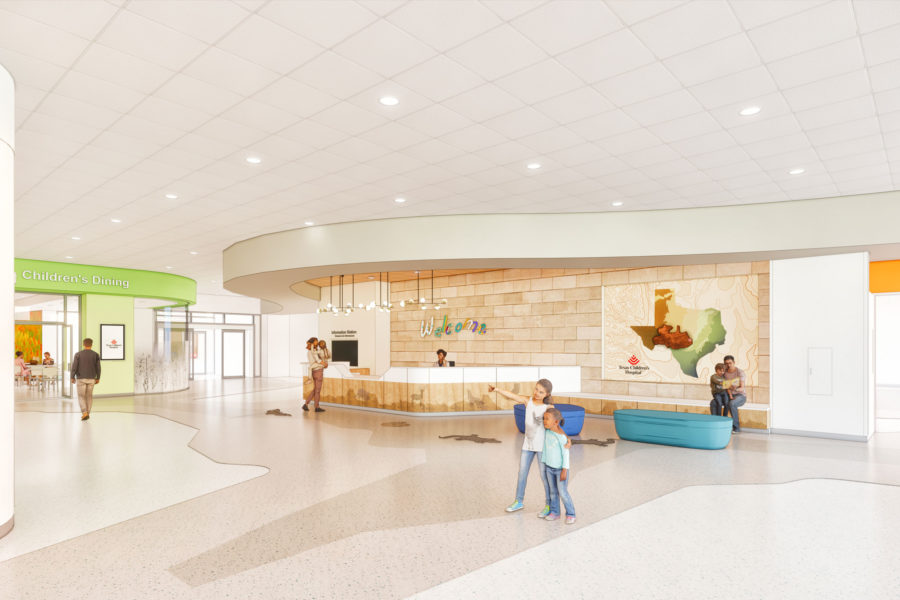
The new Texas Children’s Hospital is being designed with a calming neutral palette and splashes of color. Rendering courtesy of Texas Children’s Hospital
Beyond the look and feel of the new campus, the inner workings will focus not only on meeting the two-star rating from the AEGB program, which guides companies to design, build, and sustain healthy facilities for Austin communities, but also add an educational component that could impact generations.
From simple materials choices like using low-VOC paints to larger decisions like installing cooling towers that will collect condensate water into a pond for site irrigation, every component of the new campus’ green footprint will be a potential learning experience for visitors. Even access drives on the campus have been carefully designed to be pervious, allowing water to flow through and replenish the local water supply—a critical need in the arid landscape of central Texas. “We can teach visitors about the life cycle of that water, the need for conservation, while at the same time getting them interested in some cool engineering.”
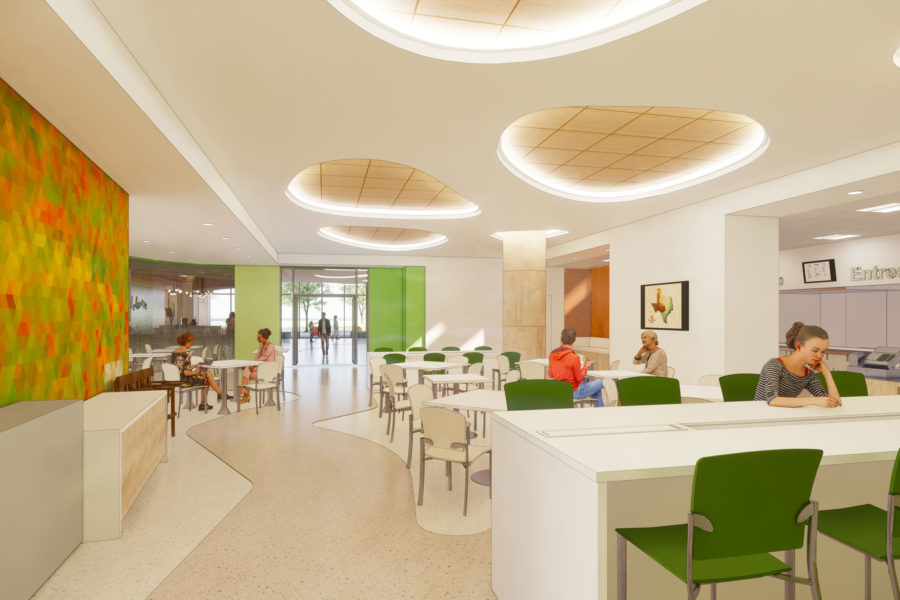
The new cafeteria will be cavern-themed with an acoustical wood ceiling, designed to draw visitors both indoors and out for dining. The team also has a plan for the menu to be educational. Rendering courtesy of Texas Children’s Hospital
One often-overlooked opportunity to educate and reduce a facility’s environmental impact is in its use of food. The cafeteria itself will be cavern-themed with an acoustical wood ceiling, designed to be a fun, educational space that draws visitors both indoors and out for their dining experience. Pearsall and her team also have a plan for the menu. “Part of our food service program will be to engage local farmers in our supply chain. All of that will be part of the educational process as well … We want to celebrate our two-star rating but also really share knowledge with the community for future generations.”

Rendering courtesy of Texas Children’s Hospital
In fact, one of the early challenges the team faced in planning for such a large campus was keeping in mind the need for future expansions and regulations. The site includes an existing wetland area and is located over the Edwards Aquifer, one of the most prolific artesian aquifers in the world. Austin also requires that new structures be solar ready. Preserving as many of the trees as possible on the 24-acre site was yet another concern. Although these issues were all addressed in the current plan, Pearsall and her team wanted to make sure future changes didn’t set them back. The best green designs, after all, are future facing.
For this the team developed a comprehensive master plan, considering things like solar footprint, sun angles, parking, connectivity, water, and energy needs—all to preserve and even improve upon the successes of their designs in the coming decades. “So when I’m no longer there and other generations come to make changes, they know how and why, where and when to put the next building and so on,” Pearsall says.
The year 2024 might be a long way off yet, and there’s still much to do, but Pearsall is already looking forward to seeing the smiling faces of patients and families as they enter campus for the first time. “I love seeing the brightness of their eyes, the excitement. That’s the best reward I get. It really is.”

